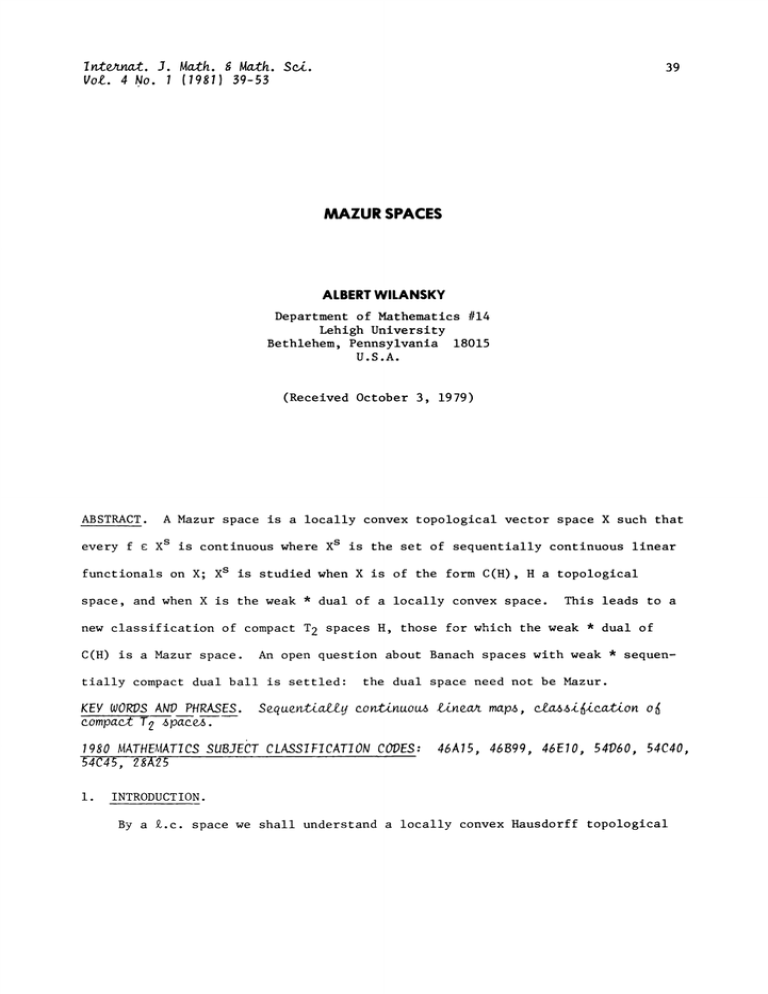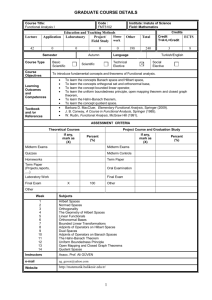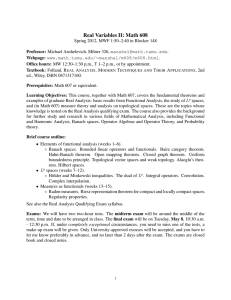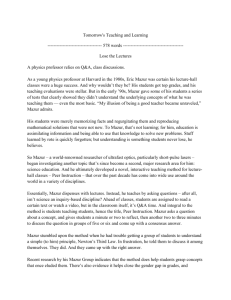ZUR SPACES J. No.
advertisement

I nternat. J. Math. Mth. Sci.
(1981)39-53
Vol. 4 No.
39
ZUR SPACES
ALBERT WlLANSKY
Department of Mathematics #14
Lehigh University
Bethlehem, Pennsylvania
18015
U.S.A.
(Received October 3, 1979)
ABSTRACT.
every f
A Mazur space is a locally convex topological vector space X such that
X s is continuous where X s is the set of sequentially continuous linear
functionals on X; X s is studied when X is of the form C(H), H a topological
space, and when X is the weak
*
dual of a locally convex space.
new classification of compact T 2 spaces
C(H) is a Mazur space.
1980 MATHEIIATICS
54C45, 28A25
i.
H, those for which the weak * dual of
An open question about Banach spaces with weak * sequen-
tially compact dual ball is settled:
KEY WORDS AND PHRASES.
compact T 2 space.
This leads to a
the dual space need not be Mazur.
Sequentially continuous linear maps,
SUBJE’CT
CLASSIFICATION CODES:
classification of
46A15, 46B99, 46E10, 54D60, 54C40,
INTRODUCTION.
By a E.c. space we shall understand a locally convex Hausdorff topological
A. WILANSKY
40
vector space over the real numbers, and use the terminology and ideas of
standard texts such as
[9], [14].
For a E.c. space
X’
X, its dual
X
of continuous linear functionals (= real valued functions) and
X’ c X
of sequentially continuous linear functionals, so that
s
s.
is the set
is the set
be a
H
Let
completely regular Hausdorff space; C(H), (respectively, C*(H)) is the set of
H; 8H, uH
real, continuous (respectively, continuous and bounded) functions on
are, respectively, the Stone-Cech and real compactifications of
8.6).
a Banach space
We shall refer several times to
convergent.
GB
spaces.
such that weak * convergent sequences in
X
=.
An example is
A Mazur space,
[15,
[13],
C*(H) with C(BH), C(H) with C(uH).
As usual we identify
REMARK 0.i.
(See
H.
See
[14],
G.B
A
space is
X’
are weakly
s
X’.
14-7.
p. 51, is a E.c. space such that
of such spaces leads naturally to a new class of compact
X
T
2
spaces
The study
called
H
spaces; those for which C(H)’ with its weak * topology is a Mazur space.
These include
from the
he
Eberlein compacts and lie at the opposite end of a spectrum
spaces, those for which C(H) is a GB space.
G
See 4 for details.
The study of Mazur spaces had its origins in an unpublished result of
S. Mazur, which is the last sentence of Th i.i.
The Theorem is known
[8], [12].
We give a new and somewhat simpler proof.
In Section 2 a generic method is given for constructing non-Mazur spaces.
Section 3 shows that the important class of weakly compactly generated Banach
spaces have Mazur duals and lays the groundwork for proving that
compacts are
question.
spaces in 4.
Eberlei
Whether the converse holds is an intriguing
Heredity properties are studied in Section 5 and in Section 6 are
considered relevant properties of Banach spaces whose duals have weak
*
sequentially compact unit discs.
I.
POI..NW,IS E C(H).
Each point
t
of
uH may be considered as a linear
HAZUR SPACES
functional on C(H), namely, to
C(H}
f
41
C(VH) we assign the number
This functional is called the evaluation at
IS ]denotes
space,
the span of
THEOREM i.i.
H
Let
pointwise topology.
For any set
t.
X
in a vector
S.
be a completely regular
Then
S
s=
[UH]
T
space, X
2
C(H) with the
i.e. a linear functional is sequentially
continuous iff it is a linear combination of evaluations at points of
particular
PROOF.
Ian-Xn(z)
r.
n
i.e.
h s H
{xn}
If
A2
F(x
-n
for each
H
n.
x(z) for
F(x)
X.
Now for
[13,
we apply this to
X
xn(h)
such that
F
Hence
x
x(z); see for example
x(h)
is a sequence in
h
In
uH.
is realcompact.
such that
and obtain
xn(h)
n)
H
and define
uH
there exists
Problem 8.5.9.
a
z
First let
x e X
each
is a Mazur space Iff
X
f(t).
x (z)
n
for each
is sequentially continuous.
The converse will be proved after three Lemmas, the first two of which
are due to A. K. Snyder.
LEMMA 1.2.
Let
infinite support
{Fn}
F
n
S
be a finite positive regular Borel measure with
on a regular
{Gn}
of closed sets and
C G
(Fn) > 0
and
n
PROOF.
and
(SN
s e S
N
G
G) > 0.
considerable if
We show first that if
V
is infinite.
,
is not the support of
so
S
s
Namely, choose
N G)
H.
Then there exist sequences
N
G
pairwise disjoint
n
SN
G
is infinite
is considerable, there exists
G
G
is open,
U
such that
U
G
is also
which has a neighborhood
({s}) < (S G)
Now
s
{G }
n.
which has a closed neighborhood
considerable:
that (S
G
space
2
of open sets with
for each
Call a set
T
such
{s)
(S G)
since
has a closed neighborhood
V
U
U c V,
with
(U) < (SN G).
Apply this with
with
G
H
U
1
G
yielding
H
obtaining
s
2
S
U
1
U
1
with considerable complement; again
with a closed neighborhood
U
2
disjoint
42
A. WILANSKY
from
U
such that (H
1
disjoint sequence
I)
U
whose interiors
G
includes a closed
n
H
Let
PROOF.
II-II=
uix(z i)
continuous on
/
X
x d.
udlB
d
X
s
T
lI
with
on
H.
Fn
and choose
u
Un
I
choice of scalars
f (u
follows that
n) 0
f(un)-tnl
noting that
LEMMA 1.4.
H.
Zl,Z2,...,zn
for
t E H
PROOF.
H
Let
and
Let
t
f
H.
Let
Finally let
Let
u E C*(H), 0
x
<
n
F
g
_<
u
0
n
I nu
f(u
n.
T
x e C*(H)
2
g e
x
[uH], f
G
f(% u
n
/
n n
g(z)
_<
0, u(z
i)
1, u(z)
it
0
for all
x(z)
0, x(t)
R)
O, g(h) # 0
1
for
n.
8H uH, and
E
one point compactification of
Then
Now for any
n
pointwise for any
0
space, z
with
i/(Iflvl).
be the
1
This is contradicted by
i
#
0
have
for
1,2,...,n.
g+u.
To complete the proof of Theorem I.i in which now
s
/
n
n
L
E
off
IUn-CnIIl< tn
be a completly regular
Zl,Z2,...,zn
+
H / R (the
f(z) =-, f e C(H).
h
for sufficiently large
Then there exists
SH
on
for it can be
G
n, and so
f (Un-Cn) dI
is
f
lUn-Cnl Ii < tn
C*(H) with
E
Since this implies that
n
8H
is infinite
Cn
Let
i.
SH
on
0
n
for all but one value of
0
E
Zl,Z2,...,zn
The Radon-Nikodym theorem implies
multiplied by a continuous function which is 1 on
n(h)
C(SH)
X.
LI(H,)and lu(h)
u
Since
C*(H)
If the result is false, the support of
We may assume also that
h, u
space, X
2
Then there exist
x
S) > 0.
(F) > 0.
n
with
n
n) _> (Gn
have (G
and the Riesz theorem gives a measure
characteristic function of
II (Fn)-
f
for all
and we may apply Lemma 1.2 to
that
F
Continuing, we obtain a
Since uniform convergence implies pointwise convergence,
f(x)
with
E
f(x)
{Gn }
be a completely regular
with the pointwise topology, and
such that
is considerable.
2
{Un }
is regular each
LEMMA 1.3.
U
glC*(H). By Lemma 1.3,
X
C(H), let
the first half of Theorem
and
43
MAZUR SPACES
the fact that
C*(H)
ux(z) + Z
n
f(x)
i=l
Lemma 1.4 and set
on
H
Uix(z i)
EXAMPLE 1.5.
u
with
/(l+kx 2)
1
0, z E 8H
for
UH.
/
u
as in
/
pointwise
0
0.
Using Theorem i.I we can give a very easy example to show
involving distribution spaces.
H
u
k
Then
that Mazur is not inherited by closed subspaces.
space,
x
Choose
1,2
k
ui/ [l+kx(zi )2]
u + 7.
f(uk)
but
X, we may assume that
is dense in
[I0]
for an example
be a Banach space; as a metrizable
H
Let
(See
is realcompact (at least for spaces of non-measurable cardinal; for
example, all known spaces.)
subspace of
H’
Then
with its weak * topology is a closed
C(H), (in addition it is sequentially complete.)
H’
Mazur by Theorem I.i but
is not if, for example,
Now
H
C(H) is
See Remark 0.i.
It follows that there is no extension theorem for sequentially continuous
linear functionals.
REMARK 1.6.
The Nachbin-Shirota theorem has been extended in
Prop. 5.2: C(H)
compact and iff C(H)
SAME CONVERGENT
op..en topolocjy is Mazur iff H
compact
wit. the
[I],
is real-
is Mazur in its weak topology.
SEQUENCES.
In this section we give a generic method for
constructing non-Mazur spaces.
Among the applications are an improvement of
2.
Example 1.5 and a simplified treatment of a result of J. Isbell.
.c.
Topology
T
.c.
A
THEOREM 2.1.
1
space (X,T) is a non-Mazur space if
such that (X,T
I)
convergent sequences.
PROOF.
A slightly stronger result is true.
and that every
(X,TI)’
C
’
(X,T)’ and
(X,TI)
convergent sequence is
T
s
C
(X,T)
s
(X,T)’.
We give three applications.
Remark 0.i, and X
(B’,weak *).
1
have the same
Suppose that (X,T) is Mazur
convergent.
I
has another
Then
//
First let
Then
T
T, T
X
X
B
be a non-reflexive
is not Mazur.
GB
space,
A. WILANSKY
44
I1
c
II-If 1
(the Mackay topology) and
O
Hence (,
[14],
D. J. H. Garling (see
EXAMPLE 2.2.
i,Co))
Prob. 14-2-107) showed that
have the same convergent sequences.
Thus a space with the Mackey
is not a Mazur space.
topology need not be Mazur.
EXAMPLE 2.3.
be a Banach space and
B
Let
subspace of (B’, norm).
the same convergent sequences.
[B,(B,S)]
15-1, 15-2, Problems 12-2-107,
spa.ca.
B’
proper subspace of (B’, norm).
(See Example 2.6).
Mazur by Theorem I.i.
BIHc
X
Let
be a Banach space and
B
S, the span of
such that
a
H
C(H) (pointwise) with
Let
Compare Example 1.5.
a weak * compact set in
B’.)
in
B
is not Mazur.
A non-Mazur closed subspace of
EXAMPLE 2.4.
compact metric
[14],
(Apply these to the natural embedding of
9-3-104, Theorem 9-3-4.
By Theorem 2.1
See
B, have
w, the weak topology of
(B,S) and
Then
a dense barrelled proper
S
H
H, is a barrelled dense
Then
C(H), considering
[C(H), pointwise]
is
Bc B’.
is
X
Then
not a Mazur space by Example 2.3 since its (pointwise) topology is
(X,S)
(B,S).
is closed in
X
That
C(H)
will now be proved under
weaker hypotheses.
LEMMA 2.5.
Note that
PROOF.
F e C(H),
xU(h)
by
F(7.
tihl
if
s
7. t h
H
F(h)
/
.c.
i
7. u .h
1
i
1
7. u
1
in which
H
(as in Example 2.4).
C(H).
(B’ ,B).
to
F
Let
u
x
be a net in
S, the span of
H
X,
B’,
in
This extension is well-defined, hence linear, since
we have
.(h i)
Now
1
In
Extend
7.
t.F(h
1
continuous, thus
EXAMPLE 2.6.
h e H.
BIH
H C B’, X
space,
has the topology
for
Zt.F(hi).
1
u i
lim 7. u .X (h
C(H)
be a
is a pointwise closed subspace of
X
Then
B
Let
F
i
u(h i
lira 7. t.x
1
is a linear
functional
lim xu(s)
S
on
which is
F e B.
[7],
p. 223, J. Isbell gives a non-Mazur subspace
is the Cantor set, not considering whether
X
X
is closed.
of
45
MAZUR SPACES
His ultimate aim was to find such a subspace of countable dimension.
(Our proof in 2.4 of the
show that his example has the properties we require.
non-Mazur character of the subspace is different from Isbell’s).
O’s and
the set of all sequences of
(=,i)
H
be
H,
and, on
so that
2
coincides with the product topology of
see
is dense and barrelled:
3.
Hc
So
Let
is the Cantor
H
Our task fs completed by Rxample 2.4 and the observation that the span of
set.
H
l’s.
We shall
[14],
Example 15-1-13.
.c.
In many situations involving a
WEAK * DUALS.
X’
greatest interest is the Space
space
X, the object of
To mention only
with the weak * topology.
three examples:
interesting forms of the closed graph theorem have been
given involving
X
see
such that (X’,weak *) is sequentially complete:
[14],
Problem 15-3-110; Banach spaces in which the dual disc is weak * sequentially
[4];
compact have been studied as members of a variety in
famous discovery that
and Grothendieck’s
GB space deals with the weak * dual of this
is a
space.
In this and the next 3 sections we pursue the study of these duals.
any
c. space
X’.
continuous linear functionals on
sX c X".
X
X
a
BB
It is clear that
space iff
Banach space is
BB
X
and
GB
iff
to be a Banach space we have
X
X
is a
GB
space.
(X’, weak *) is a Mazur space.
We shall call
Obviously a
iff it is reflexive.
GB space
condition is not sufficient
the set of weak * sequentially
Taking
X"
sX
i.e.
sX
We remark that a
*)s
(X’, weak
sX
X, let
For
[Take
satisfies
X
X
c
o
[X’,T(X’,x)]S=x
and apply
but the latter
2.2.]
It is convenient to work in more generality to show the role of complete-
ness.
(X’
Let a Z.c. space
X
be called a
DEc space
if
sX
X
i.e.
weak *) is Mazur.
THEOREM 3.1.
A
Bc
space is complete in its strong topology.
A. WILANSKY
46
PROOF.
[14],
This is by
This is improved by:
space is complete.
[14],
f e A, f
n
n
sequentially closed for if
is equicontinuous so that
F
{f }
A
space is complete.
X’.
continuous linear functional on
aw*
be an
F
Let
this and the rest of the proof see
Thus
c
A sequentially barrelled
THEOREM 3.2.
PROOF.
A special case is that a barrelled
Cor. 8-6-6.
/
12-2.).
is weak *
f, the hypothesis yields that {f }
n
is weak * sequentially continuous and so, by hypothesis it is
The result follows by Grothendieck’s completeness theorem.
continuous.
In the converse direction we give a quite general criterion.
is called N sequential if for
T
topological space
Let
THEOREM 3.3.
X’
tinuous set in
be a
X
.c.
complete space such that each equiconis a
X
Then
with the weak * topology is N sequential.
F e sX
Let
the weak * topology.
/
n
contains
A C T, t e A, A
space.
PROOF.
a
A
t.
a sequence converging to
c
f e A.
A; hence
is weak * closed in
n
#
A
Then
(For
lim f(a
F
continuous, i.e.
is
E
be an equicontinuous set in
n
E
F[A].
a
Then there exists
A C E, f e A.
Let
F(f)
f, hence
and let
F[] F[A]
Thus
aw* continuous.
n
X’
e A
and so
with
with
FIE
By Grothendieck’s theorem,
is
F
is continuous.
COROLLARY 3.4.
A separable complete
COROLLARY 3.5.
Every closed subspace
Banach space
PROOF.
Let
Now
is onto.
i
D
x
Y
space is a
c
space.
of a weakly compactly generated
BB space.
is a
X
.c.
Y
/
X
Then
be inclusion.
is an Eberlein compact by
[3],
i’
D
x
/
Dy
(The unit discs)
Corollary 5.2.3 and so
is also by
[2].
The result follows from 3.3 since Eberlein compacts are
sequential
[14],
14-1.
Dy
N
47
MAZUR SPACES
REMARK 3.6.
whose language we use without explanation.
If
since each equicontinuous set is metrizable.
X
complete, equivalently
c.
is
is separable m(X)D T (X,X’)
X
So
This is 3.4.
9
(X) c
T
EXAMPLE 3.7.
and so
T
m(X)
complete implies
X
9(X)
Also
smallest sequentially barrelled topology so, if (X,T)
barrelled;
[i]
Some of these results can be deduced from Prop. 4.1 of
is the
is sequentially
is complete, yielding 3.2.
The converse of Corollary 3.5 is false, i.e. a
space
B
need not be weakly compactly generated, or even a subspace of such a space.
Our example assumes the continuum hypothesis.
If
c.
[i],
space by
B
This is a
Let
i(I)
X
To prove the assertion,
p. 29, Remark.
D c X’
it suffices by the argument of 3.5 to show that the disc
weak * sequentially compact, hence not N sequential.
I
[0,i], X’
k
0 i,..
E[I].
[1/2(n-l)];
f (h)
Let
otherwise.
-i
fJ gn
weak * (hence pointwise) then
g
0
almost everywhere.
4.
p
AND
that
G
C(H)
studied.
SPACES.
is a
See
[14]
THEOREM 4. i.
PROOF.
GB
A
G
for every interval
0
pB
space.
C(H)
c I.
/
g
Hence
H
T
2
space
H
such
spaces have been extensively
G
Only a finite space is both
This is by 3.5 since
j
gn
for all h.
1
Each Eberlein compact
for some
has a subsequence
n
space (p space) is a compact
space, (a
14-7.
/
g(h)
But
{f }
If
is not
Take
if 2k/n < h < (2k+l)/n
1
n
with
p
and
G.
space.
is a
is weakly compactly generated;
[3]
Prop 4.2.1.
This includes all compact metric spaces, a result which also follows from
3.4; and the one point compactification of a discrete space.
We conjecture that the converse is false; that
not Eberlein compacts.
5.
HEREDITY.
p
spaces exist which are
This is made even more plausible in the next section.
The four properties
GB, G, B,
obey the following table
A. WILANSKY
48
whose entries will be discussed below:
The row headed
space is a
Q
GB
G
BB
B
Q
yes
no
no
yes
c
no
yes
yes
?
signifies that a quotient of a
GB (respectively,
GB (respectively, B) space; but a quotient of a
B) space need not be a
G (respectively, B) space.
G (respectively,
The row headed
C
signifies that a closed subspace of a G (respectively, B) space is a
(respectively, B)
GB
space.
space but a closed subspace of a
G
space need not be a
GB
It is thus most natural to conjecture that a closed subspace of a
space need not be a
space.
An example to verify this would also settle
the conjecture of 4 since a closed subspace of an Eberlein compact is also an
Eberlein compact.
The properties given for
+
(
are well known.
integers) is a quotient map from a
Since a quotient of a
subspace of
GB
a
G
GB
space is a GB
space is a
is a quotient map from a
B
space.
G
The natural map form
space onto a non-G
G
space.
space it follows that a closed
The natural map from
space to a non-B space.
quotients will follow when we show (Corollary 5.2) that
i(I)
/
Inheritance of
=
B by
B is inherited
by closed subspaces.
We need the concept of a Tauberian map
property that
X"
F
u"F e Y
implies
u
F e X
X
/
Y i.e. a map with the
All we need is that the
inclusion map from a closed subspace is Tauberian; see
LEMMA 5.1.
Let
exists a Tauberian
PROOF.
If
Y
u
be a
X + Y.
F e sX, then
COROLLARY 5.2.
BB
B
space, X
Then
u"F
X
is
sY
Y
[14],
Th. 11-4-5.
a Banach space and suppose there
B.
hence
F
X.
is inherited by closed subspaces.
49
MAZUR SPACES
There is also a 3-space theorem:
COLLARY 5.3.
is
If
has a reflexive supspace
X
X/S B
with
S
then
X
B.
PROOF.
F E sX, q"F
If
E
X/S.
s(X/S)
Since
q
is Tauberian, the
result follows.
6.
SEQUENTIAL COMPACTNESS.
the unit disc in
X’
Let us call a Banach space
is weak * sequentially compact.
space if
an SCB
X
Every closed subspace
of a weakly compactly generated space is an SCB space as shown in 3.
[5]
interest attaches to the study of SCB spaces due to the proof in
non-SCB space has a separable quotient.
that every SCB space is a
B
Some
that every
It was conjectured by Faires
[4]
That this is false is shown by means of
space.
Example 6.1 due to W. Schachermayer which is published here with his kind
permission.
(The slightly stronger condition of 3.3 is sufficient.
By 3.5
it follows that an SCB space need not be (a closed subspace of) a weakly compactly generated space.
By analogy with 4 a compact
C(H)
is an SCB space.
space
2
H
is called an
Each Eberlein compact is an
conversely (Example 6.1).
[Hc D(X’)]
T
Every
SC
space if
SC
SC space but not
space is sequentially compact
but not conversely: M Talagrand presented an example at the 1979
Kent State conference of a first countable space
includes a copy of
8N.
(This shows that even an
H
such that
N
D C C(H)’
sequential space
need not be an Eberlein compact.
EXAMPLE 6.1.
(W. Schachermayer).
uncountable ordinal.
(See
[1311 14.5.)
Let
H
H
[0,]
is not a
G
convergent sequences, and not an Eberlein compact since
limit, or because it is not a
define
F e X"
by
F()
({}).
space as will be shown.
Then if
is the first
where
space since it has
is not a sequential
Let
X
C(H) and
F e X, we would have (letting
h
A. WILANSKY
50
F
Thus
which is false.
f
F()
), 0
h e H, h
be the point mass at
Bn(e)
n,
for all
exists
of (h,), H
e
for all
h
n
H
({n})
There exists
is
,
h <
an upper bound
x e X
f
F( n)
such
xdB n
[h+l ]
n
({n})
{x e X
x(i)
x e N}.
X’.
Choose
0 < i < h
for
0
Since each
e N
n
b < h
each isolated point
)) +
and
i
}, N
let
Let
{ e D
(x)
0
It is sufficient, since it is compact, to show
For this it is sufficient to find a sequence
Let
let
b
x
b < h,
[0,b)
if
i > b
or if i
if
as in 6.1.1.
h
SC
is
H
the result will follow when it is shown
For each non-isolated
0
([h+l
To prove that
as claimed.
F e sX
{x } X which is total over
n
and
n
n
that it has a sller metric.
b
xd n
F( ).
is weak * metrizable.
that
f
Then
be the characteristic function
X
as in 6.1.1 and let
D, the unit disc in
i
[0,b]
space which supports no measure.
2
{nX’.
h
Choose
It follows that
for
T
is a co)act
of the open and closed set
N
eC
hence
n.
PROOF.
{n
(b,];
and may take
hn
we obtain
MMA 6.1.2. let
n
e
n
Note that
for all
there
For any conpact subset
i e (h,).
for
0
i
By regularity this is true for all Borel sets.
0.
Doing this for each
such that,
for only countably many
0
is open, thus includes some
(e)
countable and
({i})
Since
({i})
such that
h
H
e c (h,).
whenever
0
,
h e H, h
Then there exists
n
B e X’.
-Let
PROOF.
{ }c X’.
Let
0
we will know that
is not a B-space.
LEMMA 6.1.1.
F
and so
F(h)
F e sX
and when we show
X
Fd
x ()
o
l, x
o
0
on
[0,hi.
be the characteristic function of
is countable, say
c_ c_
I 2
Cn
{Ck},
Since
let
xb(i)
n
[0,h]
is
For
b.
i
51
MAZUR SPACES
b
{x0,x
countable we have named in all a countable set of functions
N.t.
is total over
({})
b < h.
some
If
7.
b)
1,.ICXnb)
+ ({}) =({})
({b})
0;
({b})
b
if not, x
n
0.
for
0
/
M
f, the
/
xbn d
({b}) 9 0
/
(Xnb)
hence some
0.
FURTHER RESULTS
It is clear that if
topology, (X,T
T(
for
1)
l,c o
(X,T)
is Mazur.
is Mazur and
i
T
is a smaller compatible
I
This is not necessarily true if
(I,c o
T( 1, c 0) is
is not Mazur by 2.2 while
"compatible" cannot be omitted since
on
is
{b}, lintise lundedly and so by the l:unded
characteristic function of
convergence theorem,
f[0,a] x0d
(x
It
0, then, since
ec [0,hi; hence
for some
is isolated,
b
({})
If
f x0d
(x0)
0
(e)
then
0
e N
0
[0,hi U {},
supported on
If
for let
b
,x }.
n
T
is by 3.4.
1
is larger,
Also
not Mazur while the norm
is.
The following result is due to J. H. Webb.
THEOREM 7.1.
(X’
Let
X
.c.
be a
space with a Schauder basis such that
weak *) is sequentially complete
Let
f e X
s
For
n
(bl)t"
fn 7"i=i f--
1
THEOREM 7.2.
x e’X, x
X’.. Thus
Then
Z t.1b
i
X
f(x)
is a Mazur space
(b
Z t.f
1
similarly to the result that for a space
X’
X
[6]
and leads
leads to its strong sequential completeness.
[14],
T(1,co ), respectively.
[=,T((R),I)] is a Mazur space. This
Prob. 10-3-301 (in
is barrelled:), and
X
EXAMPLE 7.3.
The Schauder basis is given in
[1 T(1
where
with Schauder basis, weak *
Neither hypothesis can be omited in 7.1 as shown by
which
lira f (x)
n
f E X’
This result generallzes Theorem 2 of
sequential completeness of
i
c
O
)]
Example 2 2
[14],
Prob. 9-5-107.
follows from
7.1.
This is in contrast with
The difference lies only in the completeness part.
A. WILANSKY
52
.c.
Equivalent conditions for a
7.4.
THEOREM
space (X,T) are:
Every sequentially continuous linear map
i.
X
u
/
.c.
any
Y, Y
space, is continuous.
C-sequential
ii.
X
is
iii.
T
T
+
+
convergent sequences as
is the largest
T
Webb’s topology
PROOF.
0 (x
n
convex sequential neighborhood
U
is a neighborhood of
i => iii
(X,T)
i
/
(X,T+).
topology with the same
is called C-sequential if every absolutely
T; X
That
0.
.c.
of
[14],
The rest is
U
x
eventually whenever
/
n
0)
follows from consideration of
8.4, Probs. 128, 201.
The conditions of 7.4 do not imply that
X
has the Mackey topology;
indeed there may exist two such comparable compatible topologies, for example,
with
X
c
W (respectively, n) be the weak (respectively, norm)
let
o
+
w
Now
:pologies.
+
Finally
C-sequential.
w
Let
THEOREM 7.5.
T
n; further
(X,T)
++
T
+
for every
T
T
so
w
+
is
by the next result.
n
be a
.c.
space.
Then
+
T
is compatible with
iff (X,T), is Mazur.
PROOF.
(x,)’c
(X,T)
/:
S
=(X,T+),
(X,T)’.
/
+)’
(X,T
(X,T)
s
(x,+) ’.
A Mazur space which has the Mackey topology must be
COROLLARY 7.6.
C-sequential, but need not be bornological.
PROOF.
This follows from 7.3, 7.4 and 7.5.
It has the interesting
application that every sequentially continuous linear map from
to an arbitrary
.c.
not bornological.
0(i,co
space is continuous (by 7.3) even though this space is
Along the same lines one might conjecture that if
is C-sequential then
T
[=,T(=,I)]
T
(X,X’) is also; but this is false:
+ then T( I,
c0
is not even Mazur.
take
X
(X,T)
,
MAZUR SPACES
QUESTIONS.
Must a
subspace of a
space be a Eberlein compact?
space be a
ACKNOWLEDGMENTS.
53
Must a closed
space?
I thank D. B. Anderson, J. Diestel, E. G. Ostling,
A. K. Snyder and J. Vivian for their assistance.
REFERENCES
i.
Bellenot S. and E. G. Ostling. Completeness and intertwined completeness
of .c. spaces. Pro.___c..Camber. Phi____l. So___c. 81(1977) 25-30.
2.
Benyamini Y, M. E. Rudin and M. Wage. Continuous images of weakly
compact subsets of Banach spaces. Paci.fic J_. Math 70(1977) 309-324.
3.
Diestel, J.
4.
Faires, B.
5.
Hagler J. and W. B. Johnson. On Banach spaces whose dual balls are not
w* sequentially compact. srael J. Math 28(1977) 325-330.
6.
Hampson J. and A. Wilansky.
(1973) 221-223.
Sequences in
7.
Isbell, J. Mazur’s theorem:
Prague Conference 1961. E. Novak, Editor.
8.
Isbell, J. and E. S. Thomas. Mazur’s theorem on sequentially continuous
linear functionals. Proc. A.M.S. 14(1963) 644-647.
9.
Kothe, G.
Geometry of Banach Spaces.
Springer Lecture Notes #485.
Varieties and vector measures.
Topological Vector Spaces I.
Math. Nachrichten.
.c.
spaces.
1978.
$_tudia Math
Springer 1969.
I0.
Mankiewicz, P. Extension of sequentially continuous linear functionals
in LF-spaces. Bull. de L’Acad Polon. des Sc. 20(1972) 929-933.
ii.
Michael, E. and M. E. Rudin, Notes on Eberlein compacts.
7_2 (1977) 487-499.
12.
Mrowka, S. On the form of certain functionals.
des Sc. 5_/1957) 1061-1067.
13.
Wilansky, A.
14.
Wilansky, A. Modern Methods in Topological Vector Spaces
McGraw-Hill 1978.
15.
Wilansky, A.
Topology for Analysis.
Pc. J. Math.
Bull. de L’Acad Polon.
John Wiley 1970.
Topics in Functional Analysis.
Springer Lecture Notes #45.






